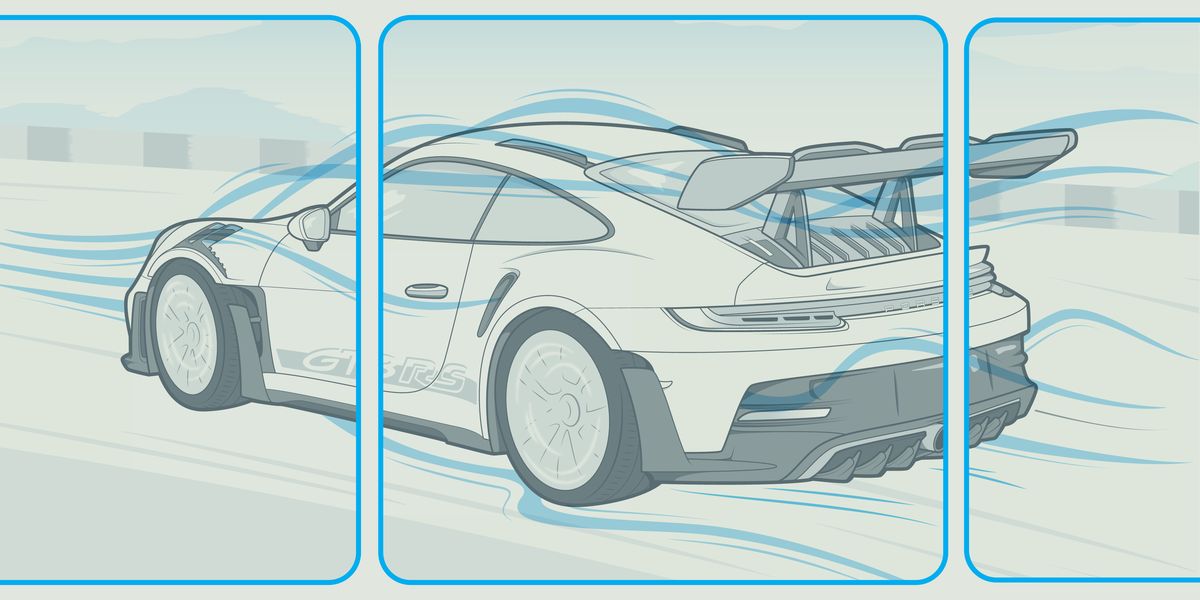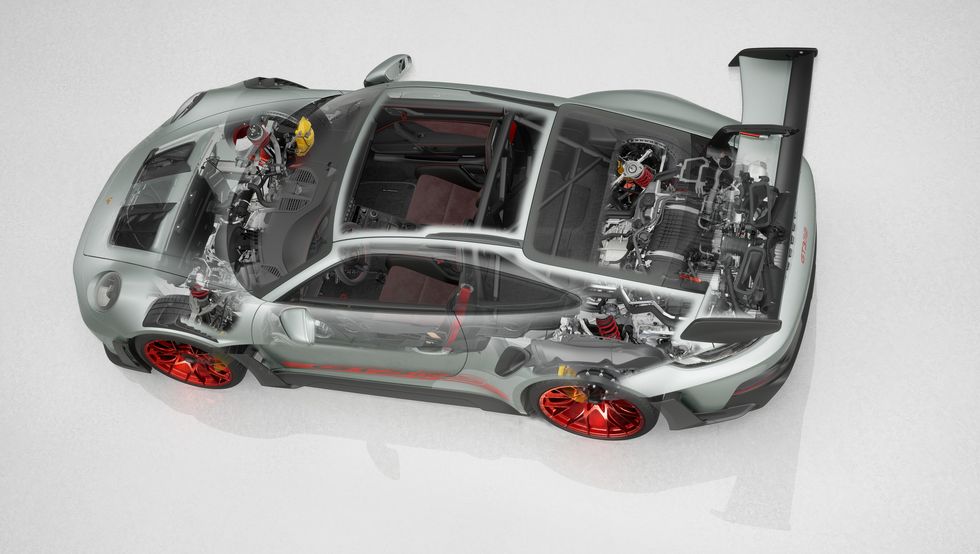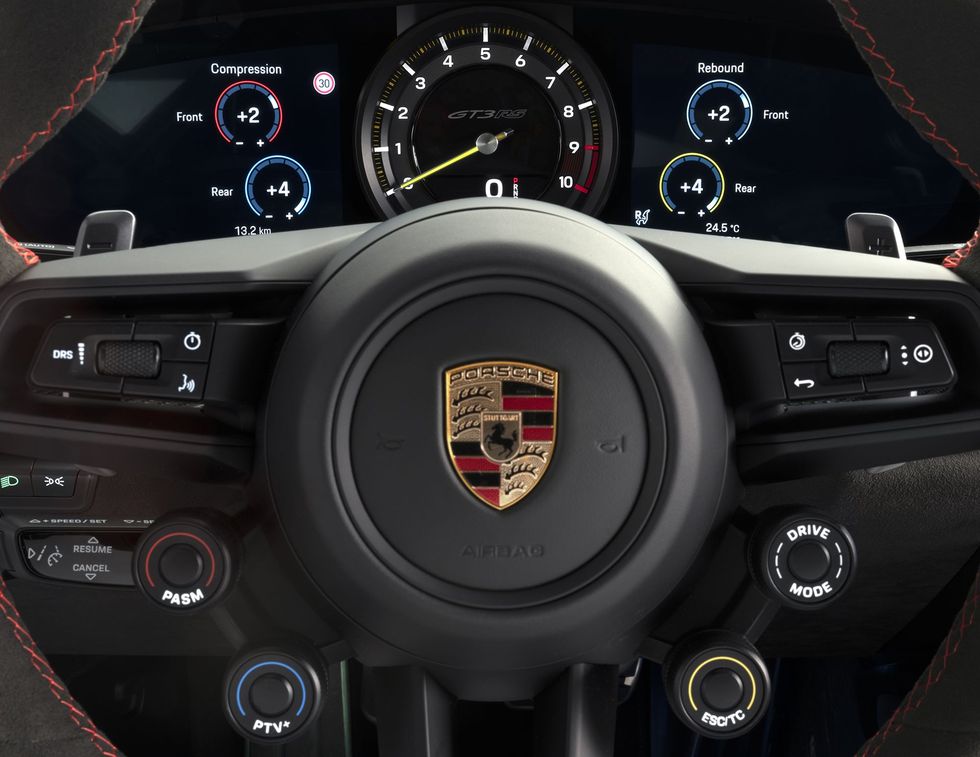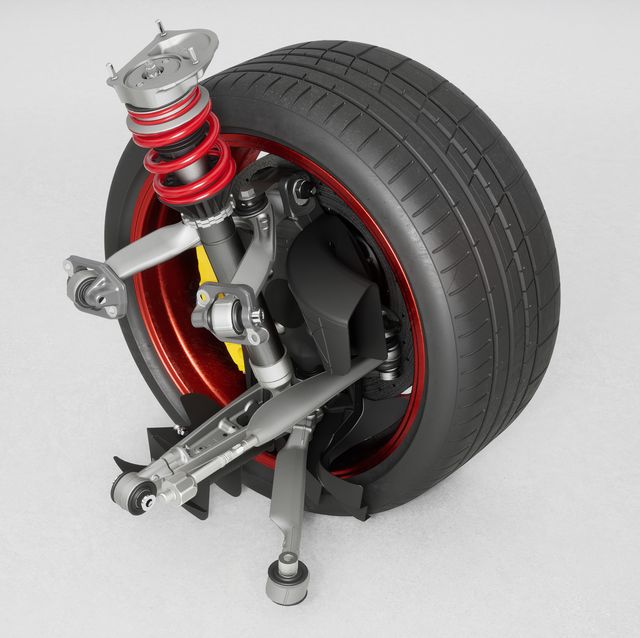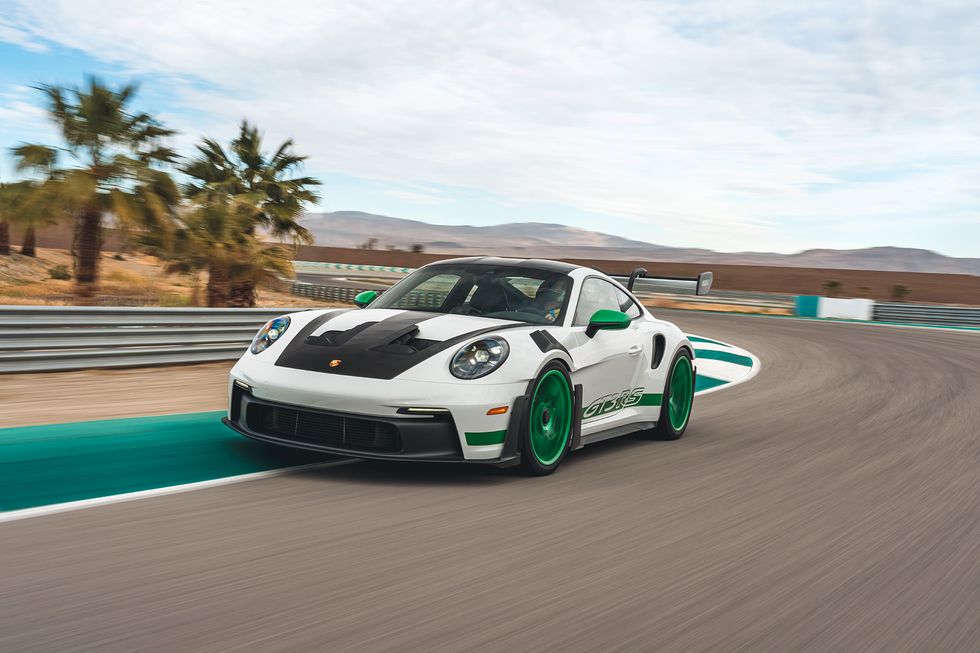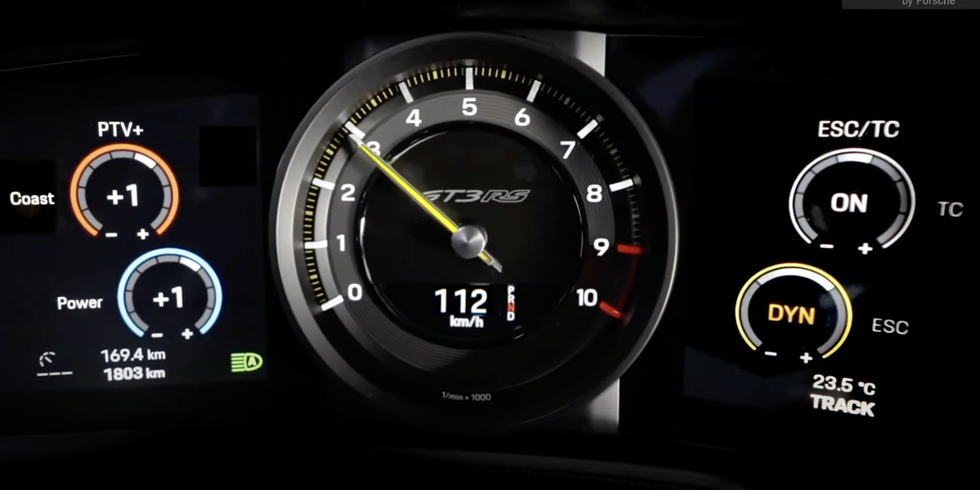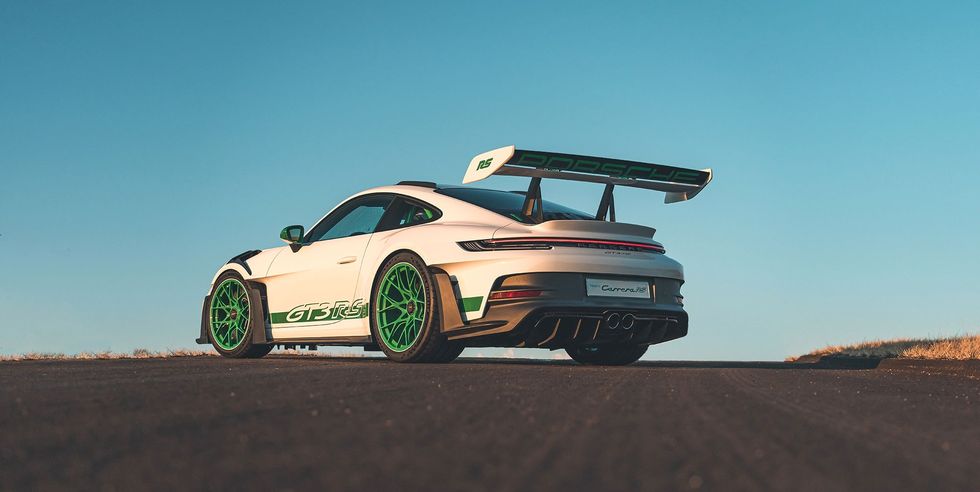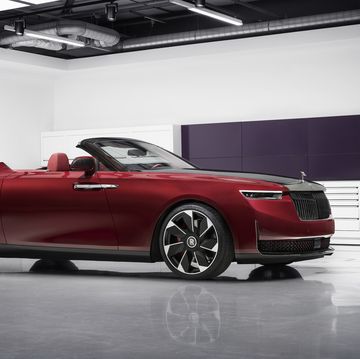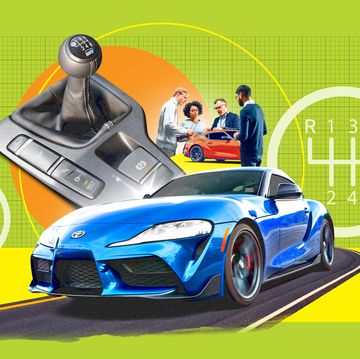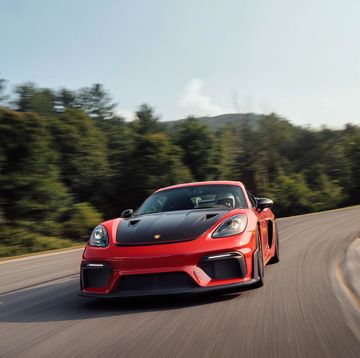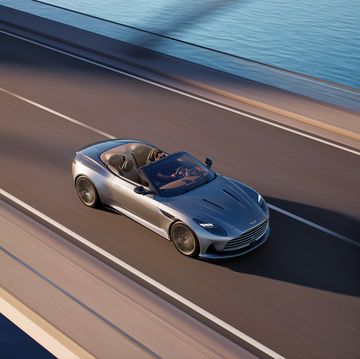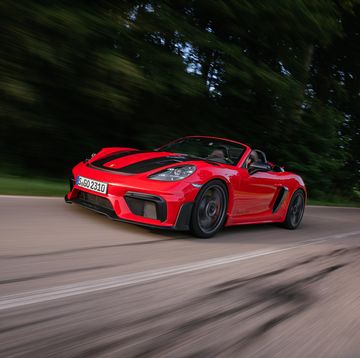Start going to track days, and it's easy to fall down the rabbit hole. The first couple of times, it's all about getting comfortable; eventually, you start going faster, getting closer to your limits and the car's; then you start looking at hardware. What about new tires? Stiffer springs? Better brakes? A new intake? There's so much stuff out there to add to your car, all of it so tempting. Then there's the car itself. Inevitably, you'll look at the stuff other people drive with lust, coming up with reasonable enough justifications to dump more money into the hobby.
The new Porsche 911 GT3 RS is the logical endpoint to all this. It is both the ultimate roadgoing track car on sale today, and the best way to indulge your curiosity, the nagging voice that says "if I tweak this," will it make me faster? It's a track-day game changer.
Porsche is blessed with one of the best engines on sale today, its 4.0-liter, 9000-rpm naturally aspirated flat-six. But it's an engine that's basically at its limit, with 518 hp in the new GT3 RS. It's enough work just getting it to keep passing emissions, so Porsche isn't really in a position to make the huge generational horsepower gains of other high-performance cars. So how do you make the car faster? Give it more toys.
Most obvious is the aero, complete with the huge rear wing with a secondary element that can stall for automatic drag-reduction on straights. It's complemented by front diffusers with movable elements that adjust in concert with the wing to maintain aero balance front-to-rear. Then there's the suspension, which has individual compression and rebound adjustments for each axle. On top of that, there's an electronic locking differential with adjustments for lockup on coast and acceleration, and an eight-stage traction control and three-stage stability control system.
The idea here is to give the driver options for how they want the car to behave, and to make those options very accessible. A lot of track cars are fit with adjustable suspension, for example, "but then I saw the people that had such cars on the paddock, lying in the grease and then fumbling around and coming back after two laps frustrated, getting back underneath the car," Andreas Preuninger, head of Porsche Motorsport's GT cars department, told R&T last year. "That's a bad deal. We have to make this accessible in real-time."
All of these systems are controlled by buttons and knobs on the steering wheel. Frankly, it's all a bit bewildering. With nine levels of adjustment between -4 and +4 for compression and rebound for front and rear, each changing the damper's valving parameters, there are 6561 different suspension settings alone. Then you get into differential settings and traction/stability control. So, where do you start?
First off, don't worry about the aero. When you put the car into Track mode, it'll take care of itself. There is a DRS button on the steering wheel if you decide you don't need as much downforce in a fast corner and want to maximize your speed on a straight, but the car opens the rear wing and adjusts the front elements very quickly once it deems it appropriate. (You can see Jorg Bergmeister hit the button on exit at the last corner before the long straight on his Nürburgring Nordschleife run.) The car's aero constantly adjusts itself, and if DRS is activated, it'll close as soon as you touch the brakes or add significant steering inputs.
Next is suspension, which is perhaps the most daunting. What should help is knowing that you can't really screw things up. The car is calibrated in such a way that there are no bad or dangerous suspension settings, especially important in something generating so much downforce. On a new track, Porsche says your best bet is to set compression and rebound to 0, the baseline factory setting, which should work well on a smooth, dry track. The curve between the lowest settings and highest settings is not linear. -4 is about 40 percent less stiff than 0, but +4 is about 100 percent stiffer, so there's a pretty wide range of adjustment.
To start making and understanding changes, you need a good comprehension of the fundamentals of damping. A damper is used to control the motions of a car's springs—without a damper, a spring would oscillate up and down infinitely after being compressed. The damper controls the motion in two directions, compression (aka bump), and rebound. As Rahal Letterman Lanigan engineer Mike Talbott explains in this great video from SafeIsFast, compression damping controls unsprung mass (wheels, tires, brakes, some suspension components), while rebound damping controls sprung mass (the body).
A guide published by Koni and long used as a reference by racers and engineers recommends starting with compression adjustments first, going until the point where the car feels a little too stiff over large bumps, then backing off. (The Koni guide is more specific to its manually adjustable shocks and recommends starting at the softest settings for compression and rebound. Because the GT3 RS has such a good baseline with all values set to 0, and because that's what the factory recommends, that's the right place to start in this instance.) On a track, rebound control will essentially dictate the speed of the body roll, though not the amount. Play with the rebound settings until you get to a desired level.
Playing with the offset between front and rear should make a huge difference in how the car handles, too. "[I]f you have your front stiffer than the rear, which is what you really want in a Porsche, you can sort of tune the understeer and oversteer characteristics of the car into and out of the corner," says Matt Cowley, owner of UK firm Suspension Secrets. If you encounter turn-in understeer, for example, Cowley recommends decreasing compression at the front or increasing compression at the rear. Upping front rebound can also help combat understeer too. To combat turn-in oversteer, do the opposite.
Working with the compression settings can also help control the pitch and dive of the car. Too much rebound at the rear can actually cause the rear wheels to lift off the ground as the nose dives. This leads to turn-in oversteer, which as Cowley says you "really don't want" with a Porsche. This can also lead to corner-exit understeer, as the front tires are lifting off the ground as the body pitches as you get back to the throttle. The key is finding the sweet spot here.
We drove the new GT3 RS at Lime Rock Park for an upcoming magazine feature, and that gave us an opportunity to learn a bit more about how to set up the car. Kyle Milikin, the guy who manages Porsche's press fleet (and a handy driver himself started with the baseline of everything on 0, and then went to +2 for rear rebound to give the car a bit more support. It worked well for us, and we were able to lap the mile-and-a-half track as quickly as anything else we've brought there.
The unique aero setup of the GT3 RS gives it more downforce than any car in production today, a maximum of 1896 pounds at 177 mph, on the low end of what a Porsche 911 RSR runs at Le Mans. Downforce in a car increases pitch sensitivity, so it's critical to keep the car level under braking and acceleration and for that, you need very stiff suspension. Despite this, the GT3 RS was remarkably compliant at Lime Rock, handling a big bump on the track's back Paul Newman Straight more gracefully than even the 718 Cayman GT4 RS we had on hand for testing.
While Lime Rock in warm, dry conditions didn't require much suspension tweaking, other tracks in other conditions will. It's all down to the driver, too. They'll need to figure out not only what they like, but how to develop their sensitivity to what the car is doing over the course of a lap. Cowley is quick to point out that different drivers want different things. A pro racer might like a bit more entry oversteer—it's a little scary and tricky to manage, but it gives you more options for how you get into a corner. A novice probably wants the rear to feel planted. One isn't necessarily faster than the other. The right suspension setting is the one that allows the driver to drive their best.
Then the driver must consider differential settings. You can change the amount of differential lock on coast—basically any time you're off throttle—and acceleration. Basically, you can adjust how much over- or understeer you want on corner entry and exit, adjusting for driver preference and track conditions. Generally speaking, a "looser" diff with less locking on entry allows for a greater difference in wheel speeds, and thus oversteer on corner entry; on corner exit, the opposite is true, which is why you see drift cars often use locked differentials. As with the suspension settings, you can adjust coast (commonly referred to as overrun elsewhere) and acceleration between values of -4 and +4, and once again, setting both to 0 should give you a good baseline. Milkin points out that the coast adjustment is especially important in a rear-engine car like the 911 to help fight its tendency to oversteer on entry. At Lime Rock, we actually set the differential to lock up a little more aggressively on acceleration, as we found the car was bogging down a bit in the track's uphill chicane. A tighter diff setting here made a big difference.
Traction control and stability control are perhaps the easiest to understand. There are three stability control settings, On, Dynamic, and Off. With stability control fully on, you can adjust traction control between 4 (labeled "On" for some reason) and 7; with stability in Dynamic, which allows for greater yaw angles, you can set traction control between 1-7; with stability off, you can set traction control anywhere from completely off to 7. The higher the value, the sooner traction control intervenes, though matter the setting, it does so seamlessly. As ever, determining the right settings depends on driver preference and track condition.
The GT3 RS should provide endless amusement for the track-day goer. With so many possible configurations, you'll probably never get bored, and while the sheer level of customization can be overwhelming, the fact that you can safely start with everything set to 0 and go from there makes things much easier. Cowley recommends using a good instructor, or a suspension expert like himself to come along to your track days so they can suggest settings they think will work. That's actually something he's doing with some GT3 RS owners next week.
Beyond the speed and downforce, the new GT3 RS is the ultimate track-toy. Whether it actually makes the driver faster is on them.
A car enthusiast since childhood, Chris Perkins is Road & Track's engineering nerd and Porsche apologist. He joined the staff in 2016 and no one has figured out a way to fire him since. He street-parks a Porsche Boxster in Brooklyn, New York, much to the horror of everyone who sees the car, not least the author himself. He also insists he's not a convertible person, despite owning three.
